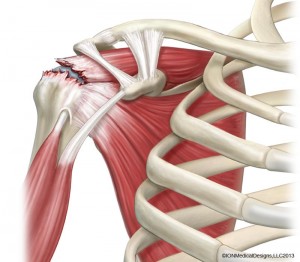Rotator Cuff Tear
Rotator cuff tears are exceptionally common and pose one of the most debilitating problems of the shoulder. There are four tendons that make up the rotator cuff. (See the shoulder anatomy). Tears can range from a small partial thickness tear of one tendon, to a full thickness tear of one or more tendons to massive tears with extensive retraction back into the shoulder. The disability is proportional to the size of the tear and whether it is acute or chronic.
The cause of rotator cuff tears can be many. Chronic repetitive work overhead, a sudden injury like a fall or simply degenerative changes can cause a tear. The rotator cuff can deteriorate with time. It can have calcium deposits which causes weakness. More commonly, the rotator cuff, with natural aging, goes through atrophic changes. Its blood supply tends to recede and causes weakness of the cuff which then is susceptible to tearing.
Symptoms are varied. They range from a painful range of motion, inability to scratch your back, pain at rest, pain with overhead activity, pain with cross chest activity to, in severe cases, an inability to actually lift your arm at all. There are many provocative tests during a physical exam that lead to the diagnosis. X-rays can show characteristic changes increasing the suspicion for a cuff tear. Lastly, in many cases, an MRI is ordered which often shows the severity of a rotator cuff tear.
Treatment for these tears is very individualized. In common tears, small and large, usually within an age group of 45 to 65, the tears can be repaired. With today’s technology, almost all of these can be done arthroscopically. The tendons are repaired with anchors that have a suture attached. The tendon is literally tied back down to bone. In an older age group, because of the usual severity of the tear and poor quality of the tendon, if the patient has acceptable function, the treatment is often non-surgical. Physical therapy usually results in pain free, although not completely normal motion. Severe massive chronic tears with significant loss of function may require a total shoulder replacement.
